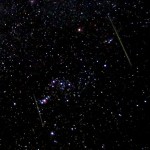Over the next few days the Perseid meteor shower will peak. As the most reliable shower each year this is also the most viewed meteor shower. Plentiful shooting stars combined with warm summer evenings makes this shower the easiest and most comfortable to view across much of the northern hemisphere.
The comfort of summer meteor observing marks quite a difference from the other reliable showers such as the Leonids and Quadrantids, that occur in November and January. Consider a warm summer night under a dark sky full of stars, a picnic blanket, relaxing while shooting stars streak across the sky. What could be better?

Active from July 17th to August 24th, the shower will build slowly for weeks before the peak. A week before or after peak the shower can still be seen with around 20 meteors each hour. With a radiant high in the constellation of Perseus this is a northern hemisphere shower, for southern observers the radiant never rises above the horizon.
A typical Perseid shower will produce up to 60-100 meteors an hour, what regular meteor observers would call 60-100ZHR. This is what a typical observer would see given a dark sky and good conditions with the shower radiant at zenith, a metric called zenithal hourly rate or ZHR.
You can estimate this rate by counting the meteors seen in a shorter period. If you count the meteors that you see for ten minutes and multiply by 6 you would have a reasonable estimate of ZHR. As the rate of meteor arrival is irregular it is necessary to count for ten minutes or more to achieve a decent average rate. Conditions such as light pollution or clouds will result in some faint meteors being missed and a lower count.

The traditional Perseid peak will occur on August 12th around 1300UT, this would be the morning of the 12th at 03:00HST for viewers in the islands. As the Perseid peak is a long and broad peak good activity can be seen for a week or more either side of this peak. This is not a shower that need be viewed right at the peak, good activity should be seen for days.
Interestingly there are predictions for possible outbursts in the hours leading up to the traditional peak. Unfortunately these predictions favor observers in Europe and eastern North America. The traditional peak should be well placed for observers in the Pacific region.
IMO observations (see WB pp. 32–36) found the timing of the mean or ‘traditional’ broad maximum varied between λ⊙ ≈ 139.◦8 to 140.◦3, equivalent to 2016 August 12, 08h to 22h UT. The orbital period of the parent comet 109P/Swift-Tuttle is about 130 years. The Perseids produced strong activity from a primary maximum throughout the 1990s. Enhanced activity ahead of the usual maximum was last seen in 2007 at λ⊙ = 139.◦68 and behind the nodal position in 2008 at λ⊙ = 140.◦55.
Results from Mikhail Maslov and Esko Lyytinen indicate that we will cross a part of the stream which was shifted closer to the Earth’s orbit by Jupiter in 2016. As a consequence, the background ZHR may reach a level of 150–160. Already on August 11, 22h34m UT the Earth should encounter small meteoroids of the 1-revolution trail causing an increase of the ZHR by about 10. At 23m23m UT brighter meteorsof the 4-revolution trail are expected.
According to calculations of J´er´emie Vaubaillon, the densest part of the stream dominated bymeteoroids of the 2-revolution trail is crossed between August 12, 00hto 04h UT (λ⊙ = 139.◦49–139.◦66), well before the broad nodal maximum. – IMO 2016 Meteor Calendar
Watching meteors requires no more equipment than your eyes and a dark sky, and can be enjoyable for just about anyone. A good meteor shower is a great excuse to get out under a dark sky and enjoy the stars. Conditions should be quite good, why not make a point to watch the Perseids this year?

